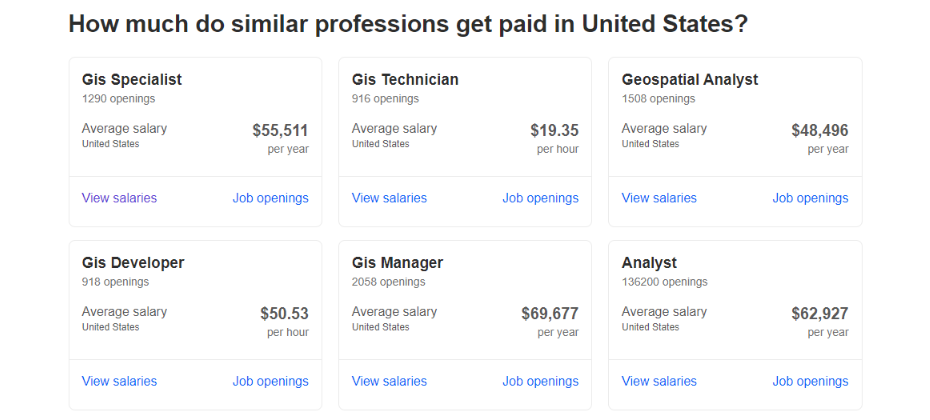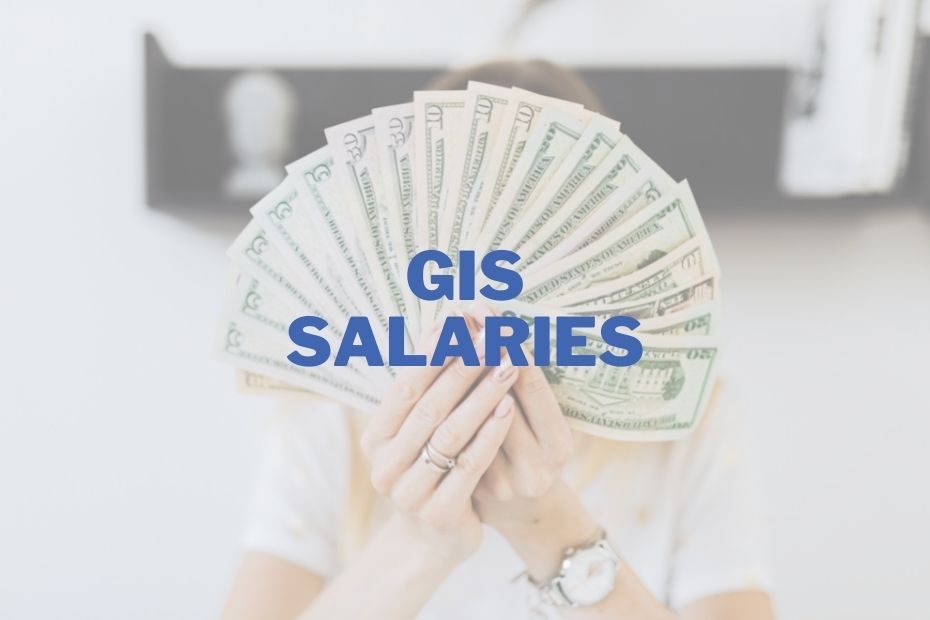GIS Salaries depend on the geographical location, company size, experience and education.
GIS is a constantly growing industry. It is the technology that provides mapping and geographic data for a number of industries, including oil and gas, transportation, public safety, and more. GIS professionals have a wide range of career opportunities with different levels of responsibility. A perfect GIS Job can pay you in a range from $11/Hours as a GIS Intern/ GIS Technician to over $100,000 as a GIS Developer.
As you know, there are a vast number of GIS professionals in the industry today. These professionals work in various industries that serve as a geographical point of interest. This article will give an introduction to the complete guide to GIS Salaries to those who are looking for this information or those who are contemplating joining this ever-growing profession.
GIS Salaries
GIS professionals are becoming more and more important in the field of geography. They have to have a Bachelor’s Degree in some form of Geographic Information Systems, Geography, or related field. They also need to be knowledgeable about relevant software, data sets, and databases.
The salaries for GIS professionals vary depending on the geographic location they are working in. For example, some states offer higher salaries than others. Some states offer lower levels of competition as well which could lead to higher salaries for GIS professionals.

The market for GIS professionals is competitive and salaries vary greatly. The average annual salary for a GIS Professional ranges from $35,000 to $100,000 per year in the United States according to indeed.com data as of January 2020.
Entry-Level GIS Career
Many entry-level GIS careers offer a salary range from $40,000 to $60,000 per year. Some jobs that require lower-level GIS skills include data entry, data input operator, data processing and geographic information systems technician.
For entry-level positions, an individual would need a bachelor’s degree in science or technology-related fields such as Geography or Environmental Science with an emphasis on geography and spatial analysis.
In order to get the most from your career in GIS, you should start with higher-level jobs and work your way down.
Some of the Entry-Level GIS Careers are GIS Technician, GIS Analyst, GIS Specialist etc.
Mid Level GIS Career Path
The position of a GIS specialist is worth a lot. The United States Department of Labor predicts that the demand for GIS specialists will grow about 10% from 2016 to 2026.
The average salary for a GIS specialist is around $60,000 per year. It can go up to $80,000 depending on the experience and qualifications of the candidate.
Some of the Mid-Level Geospatial Careers are Cartographer, Geographer, Remote Sensing Analyst, GIS Administrator etc.
Higher Level GIS Career
GIS professionals can command salaries at the higher end of the range, with salaries range starting at $80,000 and going up to $100,000 for senior-level work.
The demand for senior-level GIS professionals is on the rise. More companies are hiring them to help with their spatial data analysis, web mapping, 3D modelling, and more.
Some of the High-Level GIS Careers are GIS Software engineers, GIS Developers, GIS Project Manager etc.
Why Are GIS Salaries Are Low?
There are a number of reasons why GIS careers have low salary:
#1. GIS is a relatively new profession. The discipline itself only became popular in the 1970s and didn’t really take off until the 1990s. This means that career paths haven’t been fully established yet, so it’s difficult to determine the appropriate salary range for different positions within the field.
#2. GIS as a profession requires a mix of both technical skills as well as non-technical skills such as communication and leadership abilities, which can be challenging for employers to find in one person.
#3. Geographic information system jobs require training/education from both geographers and computer scientists, which is an added expense for employers who might not see much return on investment.
#4. Most GIS professionals have only a bachelor’s degree, which means that their salary expectations are usually not met.
Gaining Skills In 3 Key Areas To Increase GIS Salaries
A GIS professional is a combination of a field professional, computer scientist, and statistician all rolled into one. It’s easy to see why the demand for these professionals is so high. But what’s not so easy is knowing how to get the skills needed to increase your GIS salary.
The Key To Increasing Your Geospatial Salary:
- Geography: Learn about the skills and methods related to mapping and geographic information systems (GIS).
- Computer Science: Learn about various programming languages such as Python, SQL, SAS, and R.
- Statistics: Understand how data can be used in decision-making processes.
Online GIS Courses
GIS professionals should know their worth and negotiate for higher salaries. They can do this by leveraging their skills, being strategic in their job search, and by understanding the market demand.
We will discuss some of the strategies that a GIS professional can use to get a higher salary.
Online GIS Courses are a great way to learn new skills and increase salary.
Conclusion
We can conclude that GIS professionals have an exciting career ahead of them.
In just a few years, GIS has become one of the most in-demand professions in the world. The salary of a GIS professional is determined by factors such as geographical location, company size and experience.
What Are The Top Paying States For GIS Professionals?
GIS professionals are in high demand, as they can earn a median salary of $59,000. Here are the top-paying states for GIS professionals.
The following is a list of the top-paying states for GIS professionals:
1. California
2. Texas
3. Virginia
4. District of Columbia
5. Maryland
How Much Do GIS Professionals Make?
The median salary for a GIS professional is $62,500. This figure includes employees in many different career categories such as geologists, cartographers, and environmental scientists.
What Skills Or Qualities Are Needed To Be An Effective GIS Professional?
Some examples of GIS Skills that are required for this career path: GIS programming Skills & Scripting Skills, Analytical and Critical Thinking, GIS Software Specific Skills etc.
How Much Education Is Required To Become A GIS Professional?
Academic Study is the most common way of getting into the field. It involves studying geography or environmental science at the university level with an emphasis on geospatial information systems, followed by some type of postgraduate qualification or training focusing on mapping and/or spatial analysis.
